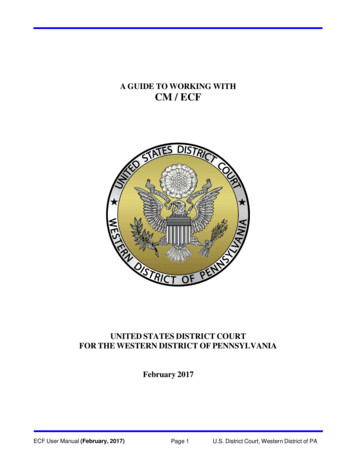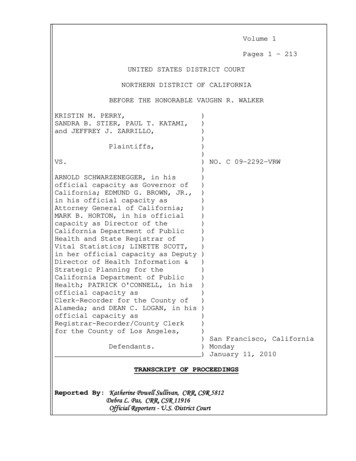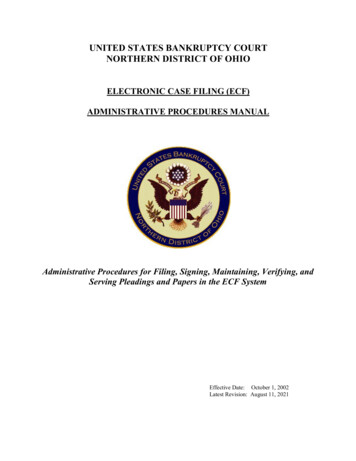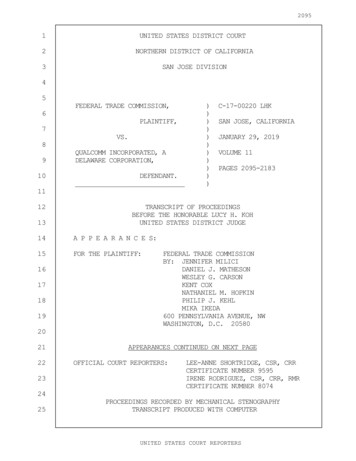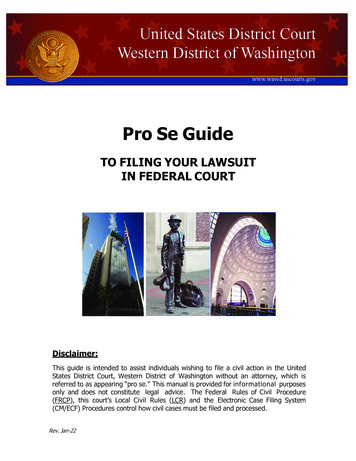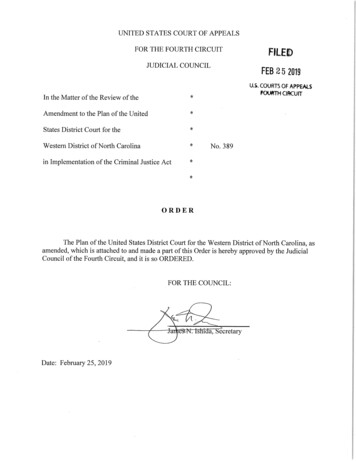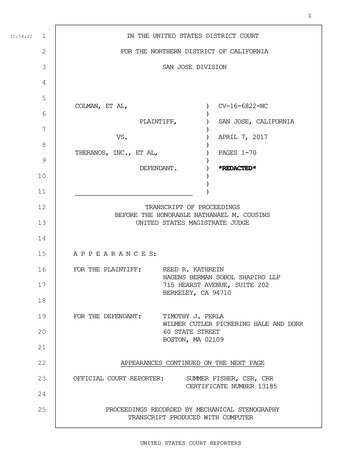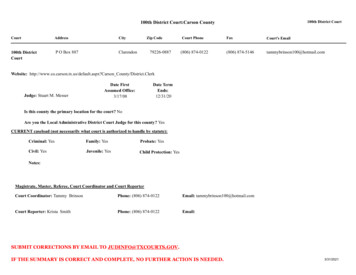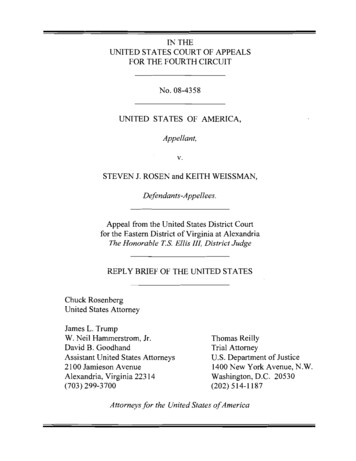
Transcription
Case 1:19-cv-00319-LGF Document 30 Filed 11/18/21 Page 1 of 45UNITED STATES DISTRICT COURTWESTERN DISTRICT OF NEW YORKNATHANIEL J. BUCKLEY,v.Plaintiff,U.S. DEPARTMENT OF V-319F(consent)MICHAEL KUZMA, ESQ.Attorney for Plaintiff1893 Clinton StreetBuffalo, New York 14206TRINI E. ROSSUNITED STATE ATTORNEYAttorney for DefendantMICHAEL S. CERRONEAssistant United States Attorney, of CounselFederal Centre138 Delaware AvenueBuffalo, New York 14202JURISDICTIONOn August 16, 2019, the parties to this action consented pursuant to 28 U.S.C.§ 636(c), to proceed before the undersigned. The matter is presently before the courton motions for summary judgment filed by Defendant on December 20, 2019 (Dkt. 13),and by Plaintiff on March 5, 2020 (Dkt. 19).BACKGROUNDPlaintiff Nathaniel J. Buckley (“Plaintiff” or “Buckley”), commenced this actionpursuant to the Freedom of Information Act (“FOIA” or “the Act”), 5 U.S.C. § 552 et seq.,
Case 1:19-cv-00319-LGF Document 30 Filed 11/18/21 Page 2 of 45on March 8, 2019, seeking an injunction and other relief, including the disclosure andrelease of agency records withheld by Defendant United States Department of Justice(“Defendant” or “DOJ”) in response to Plaintiff’s requests for information pertaining to atwo-year investigation by the Federal Bureau of Investigation (“FBI”) of Plaintiff andLeslie James Pickering (“Pickering”), and their possible involvement in domesticterrorism and an eco-terrorism 1 conspiracy. On December 20, 2019, Defendant filed amotion for summary judgment (Dkt. 13) (“Defendant’s Motion”), a Memorandum of Law(Dkt. 14) (“Defendant’s Memorandum”), the Declaration of David M. Hardy (Dkt. 15)(“Hardy Declaration”), attaching exhibits A through L (Dkt. 15-1) (“Defendant’s Exh(s).”), and a Statement of Undisputed Facts (Dkt. 16) (“Defendant’s Statement of Facts”).Also filed as Defendant’s Exh. L (Dkt. 15-1 at 51-56), is the so-called “Vaughn Index”the requested government agency is required to furnish in responding to a FOIA requestfor records, purporting to identify each piece of information responsive to a FOIArequest, as well as whether each responsive piece was released in full (“RIF”), releasedin part (“RIP”), or withheld in full (“WIF”), and the asserted reason why any informationwas withheld either in full or in part. 2 On March 5, 2020, Plaintiff filed a motion forsummary judgment (Dkt. 19) (“Plaintiff’s Motion”), the Memorandum of Law in Supportof Motion for Summary Judgment (Dkt. 20) (“Plaintiff’s Memorandum”), the Affidavit ofA precise definition of “eco-terrorism” is not provided in the record. Although Plaintiff asserts he wasinvestigated for both domestic terrorism and eco-terrorism, the parties essentially refer only to domesticterrorism and the court, in the interest of simplicity, does likewise.2 The “Vaughn Index” refers to an index prepared by the agency upon whom a FOIA request is madesetting forth all materials otherwise responsive to the FOIA request but which the agency withholds asexempt as well as the exemptions asserted as justifying the withholdings. See Vaughn v. Rosen, 484F.2d 820, 826-27 (D.C.Cir. 1973), cert. denied, 415 U.S. 977 (1974) (requiring government agency, inresponding to FOIA request, prepare a list of documents withheld as exempt, either in full or in part, andfurnish detailed justification for the asserted exemptions).12
Case 1:19-cv-00319-LGF Document 30 Filed 11/18/21 Page 3 of 45Nathaniel J. Buckley (Dkt. 21) (“Plaintiff’s Affidavit”), attaching exhibits 1 through 5(Dkts. 21-1 through 21-5) (“Plaintiff’s Exh(s). ”), and Plaintiff’s Statement of Material,Undisputed Facts and Response to the FBI’s Statement of Undisputed Facts Pursuantto Local Rule 56 (Dkt. 22) (“Plaintiff’s Statement of Facts”). In further support ofDefendant’s Motion, Defendant filed on August 28, 2020, the Reply Memorandum ofLaw (Dkt. 28) (“Defendant’s Reply”), and the Declaration of Michael G. Seidel (Dkt. 29)(“Seidel Declaration”). Oral argument was deemed unnecessary.Based on the following, Defendant’s Motion should be GRANTED; Plaintiff’sMotion should be DENIED.FACTS 3Plaintiff and Pickering are co-owners of Burning Books (“Burning Books”), anindependent book store located in Buffalo, New York (“Buffalo”), which Plaintiffdescribes as “specializing in social justice struggles and state repression.” Plaintiff’sAffidavit ¶ 2. Burning Books has hosted events featuring political activists andjournalists, and screenings of film documentaries on such topics as civil rights andenvironmental concerns, which events were monitored by undercover FBI agents andinformants. Plaintiff is an associate of Friends of the Ancient Forest, and hasparticipated in protests to prevent logging in Zoar Valley, a deep canyon river valleylocated between Cattaraugus and Erie Counties in western New York, and in “ARISSA,”a community activist organization on Buffalo’s west side. 4 In 2011, Plaintiff was34Taken from the pleadings and motion papers filed in this action.The record does not reveal whether “ARISSA” is an acronym and, if so, what each letter represents.3
Case 1:19-cv-00319-LGF Document 30 Filed 11/18/21 Page 4 of 45criminally prosecuted in Buffalo City Court for participating in an anti-war protest, 5 withstories about Plaintiff’s arrest and subsequent trial featured in local news media outletsincluding The Buffalo News, a local newspaper of general circulation, radio stationWBFO, and television news station WIVB. Commencing in January 2012 andcontinuing through January 2014, Plaintiff was the subject of a federal ecoterrorismconspiracy investigation based on Plaintiff’s association with Pickering. In connectionwith this investigation, Plaintiff sought to obtain from the FBI copies of all recordspertaining to Plaintiff and that are the subject of the instant action. Plaintiff suspectsthat some of the information that may be present in the FBI’s records would pertain tostatements made by Amy Upham (“Upham”) and Selena K. Lloyd (“Lloyd”), both ofwhom were tenants in the apartment located above Burning Books from April 2011through November 2011, and neither of whom personally liked Plaintiff or Pickering.Plaintiff further maintains that Lloyd’s animus toward Plaintiff was so great that CrisisServices, Inc. (“Crisis Services”), warned Plaintiff that Lloyd, upon being released fromErie County Medical Center’s Mental Health Unit, made death threats against Plaintiff.With regard to Plaintiff’s attempts to obtain the information from the FBI, by letterdated February 9, 2016 (“FOIA Request”), 6 Plaintiff, through his legal counsel, MichaelKuzma, Esq. (“Kuzma”), requestedany and all records that were prepared, received, transmitted, collected, and/ormaintained by the Federal Bureau of Investigation (FBI), the Terrorist ScreeningCenter, the National Joint Terrorism Task Force, or any Joint Terrorism TaskForce relating or referring to Nathaniel J. Buckley.FOIA Request at 1 (italics in original).The charges eventually were dismissed with prejudice. People v. Buckley, 967 N.Y.S.2d 868 (City Ct.2013)6 Defendant’s Exh. A (Dkt. 15-1 at 1-5).54
Case 1:19-cv-00319-LGF Document 30 Filed 11/18/21 Page 5 of 45The FOIA Request was accompanied by the required DOJ Certificate of Identity, FormDOJ-361 (“Certificate of Identity forms”), completed with Plaintiff’s information andsignature. FOIA Request at 5. By letter dated February 23, 2016 (“February 23, 2016Letter”), 7 the FBI acknowledged receipt of the FOIA Request, assigning it Freedom ofInformation/Privacy Acts (“FOIPA”) Request Number 1344909-000 (“First FOIPA”). Byletter to the DOJ dated February 6, 2017 (“February 6, 2017 Letter”), 8 Plaintiff advisedDefendant had failed to provide records responsive to the First FOIPA within 20 days ofreceiving the FOIA Request, and that Plaintiff was treating the DOJ’s failure to timelyrespond as a denial of the FOIA Request. By letter dated February 21, 2017 (“February21, 2017 Letter”), 9 the DOJ acknowledged receipt of the February 6, 2017 Letter andadvised it was being considered an appeal, assigning it number DOJ-AP-2017-002444(“First Appeal”). By letter dated March 21, 2017 (“March 21, 2017 Letter”), 10 the DOJ’sOffice of Information Policy (“OIP”), advised Kuzma that the First Appeal was withoutmerit because it was filed prior to any adverse opinion being made regarding Plaintiff’sFOIA Request, but that the OIP had contacted the FBI and the FOIA Request was beingprocessed.On November 20, 2017, the FBI released records responsive to Plaintiff’s FOIARequest (“First Records Release”), 11 advising 16 records were located and reviewed,with 14 of the records released in full or in part, explaining the withheld records wereprotected from disclosure pursuant to FOIA Exemptions 3, 6, 7(c), 7(D), and 7(E), 12 butDefendant’s Exh. B (Dkt. 15-1 at 6-8).Defendant’s Exh. C (Dkt. 15-1 at 9-10).9 Defendant’s Exh. D (Dkt. 15-1 at 11-12).10 Defendant’s Exh. E (Dkt. 15-1 at 13-14).11 Defendant’s Exh. F (Dkt. 15-1 at 15-18).12 The categories of government records exempt from disclosure under FOIA are set forth in 5 U.S.C. §552(b).785
Case 1:19-cv-00319-LGF Document 30 Filed 11/18/21 Page 6 of 45that Plaintiff could appeal the FBI’s decision by filing an administrative appeal with theDOJ’s OIP within 90 days or by seeking dispute resolution through the Office ofGovernment Information Services (“OGIS”) or the FBI’s FOIA Public Liaison. By letterdated February 6, 2018 (“Second Appeal”), 13 Plaintiff appealed to OIP for assistancewith the FBI’s alleged inadequate search and failure to reasonably segregate portions ofthe First Records Release. Included with the appeal were additional completedCertification of Identity forms authorizing the release to Kuzma of any informationresponsive to Plaintiff’s FOIA Request pertaining to John Buckley, Sarah Buckley, DaireBrian Irwin, Carrie Ann Nader, Leslie James Pickering, Theresa Baker-Pickering, SeanFrancis Raess, and Michael Kuzma. See Dkt. 15-1 at 22-29. On February 20, 2018,the OIP acknowledged receipt of the Second Appeal which was assigned number DOJAP-208-00286. 14By letter dated August 9, 2018 (“August 9, 2018 Letter”), 15 DOJ OIP advisedPlaintiff of the FBI’s actions on Plaintiff’s FOIA Request, i.e., the documents, with someredactions, included in the First Records Release, were affirmed, and that the FBIproperly withheld certain information as protected from disclosure pursuant to FOIAexemptions. The OIP also confirmed the FBI conducted an adequate and reasonablesearch for records responsive to Plaintiff’s FOIA Request, advising if Plaintiff remaineddissatisfied with the OIP’s action on Plaintiff’s Second Appeal, Plaintiff could commencean action in federal district court pursuant to 5 U.S.C. § 552(a)(4)(B). Accordingly, onMarch 8, 2019, Plaintiff commenced the instant action.Defendant’s Exh. G (Dkt. 15-1 at 19-21).Defendant’s Exh. H (Dkt. 15-1 at 30-31).15 Defendant’s Exh. I (Dkt. 15-1 at 32-35).13146
Case 1:19-cv-00319-LGF Document 30 Filed 11/18/21 Page 7 of 45On June 12, 2019, in response to a request from the FBI, Plaintiff provided newlycompleted and signed DOJ-361 forms authorizing the release to Plaintiff of informationpertaining to John Buckley, Sarah Buckley, Daire Brian Irwin, Carrie Ann Nader, LeslieJames Pickering, Theresa Baker-Pickering, Sean Francis Raess, and Michael Kuzma. 16By letter to Kuzma dated July 12, 2019 (“Second Records Release”), 17 the FBI advisedit located and reviewed 58 pages of records responsive to Plaintiff’s FOIA Request,releasing 54 pages in full or in part, with certain information withheld pursuant to FOIAexemptions 3, 6, 7(C), 7(D), and 7(E).In connection with the pending motions, explanations as to how Plaintiff’s FOIARequest was processed are provided by David M. Hardy (“Hardy”), and Michael G.Seidel (“Seidel”). Hardy was the Section Chief of the Record/Information DisseminationSection (“RIDS”), Information Management Division (“IMD”), in Winchester, Virginia,when the search for records responsive to Plaintiff’s FOIA Request occurred. HardyDeclaration ¶ 1. Hardy was succeeded by Seidel who was Assistant Section Chief ofRIDS when the relevant records search occurred, becoming Acting Section Chief May26, 2020 until July 26, 2020, when Seidel became Section Chief of RIDS, IMD, FBI.Seidel Declaration ¶ 1.According to Hardy, in fulfilling its integrated missions and functions as a lawenforcement, counterterrorism, and intelligence agency, the FBI compiles and maintainsin the Central Records System (“CRS”) records consisting of applicants, investigative,intelligence, personnel, administrative, and general files. The CRS maintains records1617Defendant’s Exh. J (Dkt. 15-1 at 36-45).Defendant’s Exh. K (Dkt. 15-1 at 46-50).7
Case 1:19-cv-00319-LGF Document 30 Filed 11/18/21 Page 8 of 45for the entire FBI organization including FBI Headquarters (“FBIHQ”), FBI Field Offices,and FBI Legal Attached Officers (“Legats”) worldwide.CRS files are numerically sequenced and organized according to designatedsubject categories referred to as “FBI classifications.” As each FBI case file is opened,the file is assigned a Universal Case File Number (“UCFN”) consisting of threesequential components including (1) the CRS file classification number; (2) theabbreviation of the FBI Office of Origin (“OO”) initiating the file; and (3) the assignedindividual case file number for that particular subject matter. Within each case file,certain documents of interest are “serialized” i.e., assigned a document number in theorder in which the document is added to the file, typically in chronological order.Records are located within the CRS through its general indices with the filesalphabetized according to subject matters including individuals, organizations, eventsand subjects of investigative interest. Entries in the general indices fall into twocategories including (1) a main entry created for each individual or non-individual that isthe subject or focus of an investigation, and (2) a reference or “cross-reference” entrycreated for individuals or non-individuals associated with a case, but not the mainsubject or focus of an investigation. Reference subjects typically are not identified in thecase title of a file. CRS indexing information is done by FBI investigators who have thediscretion to deem information sufficiently significant to warrant indexing for futureretrieval. Thus, not every individual name, organization, event, or other subject matteris separately indexed in the general indices.In 1995, Automatic Case Support (“ACS”), an electronic, integrated casemanagement system was implemented with CRS records converted from automated8
Case 1:19-cv-00319-LGF Document 30 Filed 11/18/21 Page 9 of 45systems previously utilized by the FBI into a single, consolidated case managementsystem accessible by all FBI offices. ACS searches were conducted through use of theUniversal Index (“UNI”) which provides an electronic means to search by indexingpertinent investigative information including such identifying information as name, dateof birth, race, sex, locality, Social Security Number, address, and date of an event. OnJuly 1, 2012, the Sentinel system (“Sentinel”) became the effective FBI-wide casemanagement system. Sentinel includes the same automated applications utilized inACS, and also provides a web-based interface to FBI users. Sentinel did not replaceACS, however, until August 1, 2018, when ACS data was migrated into Sentinelincluding ACS indices data and digitalized investigative records. Sentinel also retainsthe index search methodology and function whereby the CRS is queried via Sentinel forpertinent indexed main or reference entries in case files. As such, CRS index data fromthe UNI application previously searched via ACS is now searched within Sentinel usingthe “ACS Search” function.Accordingly, upon receiving FOIPA requests for information on subject matterspredating implementation of Sentinel, RIDS begins its searching efforts by conductingindex searches via Sentinel’s ACS Search function, followed by an index search ofSentinel records to ensure any subsequent records or data relevant to the FOIPArequest are located. The CRS automated indices are updated daily with searchablematerial newly indexed in Sentinel.Each page of the records responsive to Plaintiff’s FOIA Request is Batesstamped. Defendant provides a “Vaughn Index” 18 listing a description of each18Defendant’s Exh. L (Dkt. 15-1 at 51-56).9
Case 1:19-cv-00319-LGF Document 30 Filed 11/18/21 Page 10 of 45document with the associated Bates-stamped page number, and a chart indicating foreach record whether it was released in full, released in part, or withheld in full, as wellas on which FOIA Exemption Defendant relies to support withholding the information.The Vaughn Index shows Defendant identified 58 records responsive to Plaintiff’s FOIARequest, of which three were RIF, 51 were WIP, and 4 were WIF. The 58 recordsappear in 23 separately “serialized” documents (“serials”), i.e., documents arranged inchronological order.DISCUSSION1.Summary JudgmentBoth Plaintiff and Defendant move for summary judgment on Plaintiff’schallenges to the adequacy of the documents provided in response to Plaintiff’s FOIARequest in the First and Second Records Releases. Summary judgment of a claim ordefense will be granted when a moving party demonstrates that there are no genuineissues as to any material fact and that a moving party is entitled to judgment as a matterof law. Fed.R.Civ.P. 56(a) and (b); Celotex Corp. v. Catrett, 477 U.S. 317, 322 (1986);Anderson v. Liberty Lobby, Inc., 477 U.S. 242, 250-51 (1986); Miller v. Wolpoff &Abramson, L.L.P., 321 F.3d 292, 300 (2d Cir. 2003). The court is required to construethe evidence in the light most favorable to the non-moving party, Collazo v. Pagano,656 F.3d 131, 134 (2d Cir. 2011), and summary judgment may not be granted based ona credibility assessment. See Reyes v. Lincoln Automotive Financial Services, 861F.3d 51, 55 (2d Cir. 2017) (“Adverse parties commonly advance conflicting versions ofthe events throughout a course of litigation. In such instances on summary judgment,10
Case 1:19-cv-00319-LGF Document 30 Filed 11/18/21 Page 11 of 45the court is required to resolve all ambiguities and draw all permissible factualinferences in favor of the party against whom summary judgment is sought.” (citations,quotation marks, and brackets omitted)). The party moving for summary judgmentbears the burden of establishing the nonexistence of any genuine issue of material factand if there is any evidence in the record based upon any source from which areasonable inference in the non-moving party's favor may be drawn, a moving partycannot obtain a summary judgment. Celotex, 477 U.S. at 322; see Anderson, 477 U.S.at 247-48 (“summary judgment will not lie if the dispute about a material fact is“genuine,” that is, if the evidence is such that a reasonable jury could return a verdict forthe nonmoving party”). “A fact is material if it ‘might affect the outcome of the suit undergoverning law.’” Roe v. City of Waterbury, 542 F.3d 31, 35 (2d Cir. 2008) (quotingAnderson, 477 U.S. at 248).“[T]he evidentiary burdens that the respective parties will bear at trial guidedistrict courts in their determination of summary judgment motions.” Brady v. Town ofColchester, 863 F.2d 205, 211 (2d Cir. 1988)). A defendant is entitled to summaryjudgment where “‘the plaintiff has failed to come forth with evidence sufficient to permita reasonable juror to return a verdict in his or her favor on’” an essential element of aclaim on which the plaintiff bears the burden of proof. In re Omnicom Group, Inc., Sec.Litig., 597 F.3d 501, 509 (2d Cir. 2010) (quoting Burke v. Jacoby, 981 F.2d 1372, 1379(2d Cir. 1992)). Once a party moving for summary judgment has made a properlysupported showing of the absence of any genuine issue as to all material facts, thenonmoving party must, to defeat summary judgment, come forward with evidence thatwould be sufficient to support a jury verdict in its favor. Goenaga v. March of Dimes11
Case 1:19-cv-00319-LGF Document 30 Filed 11/18/21 Page 12 of 45Birth Defects Foundation, 51 F.3d 14, 18 (2d Cir. 1995). “[F]actual issues created solelyby an affidavit crafted to oppose a summary judgment motion are not ‘genuine’ issuesfor trial.” Hayes v. New York City Dep’t of Corrections, 84 F.3d 614, 619 (2d Cir. 1996).“An issue of fact is genuine and material if the evidence is such that a reasonable jurycould return a verdict for the nonmoving party.” Cross Commerce Media, Inc. v.Collective, Inc., 841 F.3d 155, 162 (2d Cir. 2016) (citing SCR Joint Venture L.P. v.Warshawsky, 559 F.3d 133,137 (2d Cir. 2009)).In the instant case, Defendant argues in support of summary judgment the FBI’ssearch of records responsive to the FOIA Request was adequate, Defendant’sMemorandum at 6-8, Plaintiff has no right to the requested records that are within thepurview of the Privacy Act, id. at 8-10, and the FBI’s FOIA Request response wasproper because it complied with segregability requirements, id. at 10-11, as well as withthe asserted FOIA exemptions, id. at 12-18. In response to Defendant’s Motion and insupport of Plaintiff’s Motion, Plaintiff argues the FBI’s investigations of Plaintiff do notqualify for FOIA’s law enforcement exception, Plaintiff’s Memorandum at 1-3, requeststhe court order the FBI release the non-exempt portions of the records, id. at 3-4,maintains the FBI’s search for records was inadequate, id. at 4-5, asserts the FBIimproperly withheld information based on the various FOIA exemptions, id. at 5-12, andrequests an award of attorney fees and costs incurred in connection with this action. Id.at 12. In reply, Defendant argues the FBI’s search for records responsive to Plaintiff’sFOIA Request was adequate, Defendant’s Reply at 2-5, and the FBI’s response to theFOIA Request was proper with regard to segregability, id. at 5-7, as well as with regardto information withheld pursuant to the various asserted FOIA exemptions, id. at 7-19,12
Case 1:19-cv-00319-LGF Document 30 Filed 11/18/21 Page 13 of 45and maintains not only is Plaintiff’s argument in support of attorney fees an argumentthat is premature on summary judgment, id. at 20, but that even if such request wereripe for determination, the circumstances of the instant action do not support such anaward. Id. at 20-23.2.FOIA Overview“The Freedom of Information Act adopts as its most basic premise a policystrongly favoring public disclosure of information in the possession of federal agencies.”Halpern v. F.B.I., 181 F.3d 279, 286 (2d Cir. 1999) (citing cases). “As noted by theSupreme Court, under FOIA, ‘federal jurisdiction is dependent on a showing that anagency has (1) ‘improperly’ (2) ‘withheld’ (3) ‘agency records.’’” Grand Cent.Partnership, Inc. v. Cuomo, 166 F.3d 473, 478 (2d Cir. 1999) (quoting U.S. Dep't ofJustice v. Tax Analysts, 492 U.S. 136, 142 (1980) (quoting Kissinger v. ReportersComm. for Freedom of Press, 445 U.S. 136, 150 (1980))). “Only when each of thesecriteria is met may a district court ‘force an agency to comply with the FOIA's disclosurerequirements.’” Id.“[T]he strong presumption in favor of disclosure places the burden on the agencyto justify the withholding of any requested documents.” U.S. Dep't of State v. Ray, 502U.S. 164, 173 (1991). The agency has the initial burden to show it conducted anadequate search for responsive records. Carney v. U.S. Dep't of Justice, 19 F.3d 807,812 (2d Cir.), cert. denied, 513 U.S. 823 (1994). A search is considered adequate if itwas reasonably calculated to uncover all relevant documents, yet reasonableness doesnot demand perfection, and a reasonable search need not uncover every documentextant. Grand Cent. Partnership, Inc., 166 F.3d at 489.13
Case 1:19-cv-00319-LGF Document 30 Filed 11/18/21 Page 14 of 45“The FOIA requires that agency records be made available promptly upon arequest that ‘reasonably describes such records and . is made in accordance withpublished rules stating the time, place, fees (if any), and procedures to be followed.’”Ruotolo v. Dep’t of Justice, Tax Division, 53 F.3d 4, 9 (2d Cir. 1995) (quoting 5 U.S.C. §552(a)(3)). FOIA, however, exempts from disclosure nine categories of information. 5U.S.C. § 552(b)(1) through (9) (“Exemption (b)( )”). “Accordingly, to prevail on asummary judgment motion in a FOIA case, an agency must demonstrate ‘that eachdocument that falls within the class requested either has been produced, isunidentifiable, or is wholly exempt from the Act's inspection requirements.’” Ruotolo, 53F.3d at 9 (quoting Nat'l Cable Television Ass'n Inc. v. FCC, 479 F.2d 183, 186 (D.C. Cir.1973)). Furthermore, “‘to prevail on a motion for summary judgment in a FOIA case, thedefending agency has the burden of showing that its search was adequate.’” Id.(quoting Carney, 19 F.3d at 812).“‘Affidavits submitted by an agency are accorded a presumption of good faith;accordingly, discovery relating to the agency's search and the exemptions it claims forwithholding records generally is unnecessary if the agency's submissions are adequateon their face.’” Nat. Res. Def. Council, Inc. v. U.S. Dep't of Interior, 36 F. Supp. 3d 384,398 (S.D.N.Y. 2014) (quoting Carney, 19 F.3d at 812 (citation omitted)). “‘In order tojustify discovery once the agency has satisfied its burden, the plaintiff must make ashowing of bad faith on the part of the agency sufficient to impugn the agency'saffidavits or declarations, or provide some tangible evidence that an exemption claimedby the agency should not apply or summary judgment is otherwise inappropriate.’” Id.(citations omitted).14
Case 1:19-cv-00319-LGF Document 30 Filed 11/18/21 Page 15 of 45“Summary judgment is the preferred procedural vehicle for resolving FOIAdisputes.” Bloomberg, L.P. v. Bd. of Governors of Fed. Reserve Sys., 649 F.Supp.2d262, 271 (S.D.N.Y. 2009). “In order to prevail on a motion for summary judgment in aFOIA case, the defending agency has the burden of showing that its search wasadequate and that any withheld documents fall within an exemption to the FOIA.”Carney, 19 F.3d at 812. In contrast, “‘[s]ummary judgment in favor of [a] FOIA plaintiffis appropriate when an agency seeks to protect material which, even on the agency'sversion of the facts, falls outside the proffered exemption.’” Nat. Res. Def. Council, Inc.v. U.S. Dep't of Interior, 36 F.Supp.3d 384, 398 (S.D.N.Y. 2014) (quoting NY. Times Co.v. U.S. Dep't of Def., 499 F.Supp.2d 501, 509 (S.D.N.Y. 2007)). In resolving a summaryjudgment motion in a FOIA action, the district court conducts a de novo review of anagency's response to a FOIA request including any government records which theagency claims are exempt from disclosing. See Lee v. F.D.I.C., 923 F.Supp. 451, 453(S.D.N.Y. 1996) (citing 5 U.S.C. § 552(a)(4)(B); Dep’t of the Air Force v. Rose, 425 U.S.352, 361-62 (1976). Such “de novo review requires the court to reweigh the evidencecompiled by the agency to determine whether the agency's findings are correct, not justwhether they are reasonable.” Id. at 453-54. Although FOIA authorizes in camerainspection of the documents in question, it is not required. Id. (citing 5 U.S.C. §552(a)(4)(B)).3.FBI FOIA RequestAs stated, Plaintiff’s challenge to the information released by the FBI in responseto Plaintiff’s FOIA Request includes that the FBI improperly withheld informationpertaining to an investigation of Plaintiff for exercising his First Amendment rights,15
Case 1:19-cv-00319-LGF Document 30 Filed 11/18/21 Page 16 of 45Plaintiff’s Memorandum at 2-3, requests the court order the FBI release non-exemptportions of the requested records the FBI erroneously maintains are “inextricablyintertwined” with exempt portions, id. at 3-4, the FBI’s records search was inadequate,id. at 4-5, and the FBI improperly withheld information based on various FOIAexemptions. Id. at 5-11. The court addresses each of these argument in turn.A.Propriety of InvestigationAt the outset, Plaintiff argues that the Privacy Act of 1974, 5 U.S.C. § 552a (“thePrivacy Act”), specifically forbids any agency from maintaining records describing howany individual exercises First Amendment rights unless, as relevant here, such recordsare pertinent to or within the scope of authorized law enforcement activity. 5 U.S.C. §552a(e)(7). Plaintiff’s Memorandum at 2. According to Plaintiff, the investigationconducted by the FBI between 2012 and 2014, into Plaintiff and Pickering’s possibleinvolvement in domestic terrorism and eco-terrorism based on their activities at BurningBooks was illegal because the activities being investigated consisted of guest speakersat events promoting social justice and the environment, as well as exposing the plight ofpolitical prisoners, all activities entitled to First Amendment protection. Id. As such, forthe FBI to invoke FOIA Exemption (b)(7) (exempting from disclosure under FOIA sixcategories of “records or information compiled for law enforcement purposes) assupporting the withholding of documents responsive to Plaintiff’s FOIA Request, the FBImust establish the documents pertain to investigative activities complying with thePrivacy Act, i.e., that “were realistically based on a legitimate concern that federal lawshave been or may be violated or that national security may be breached,” particularly,as relevant here, involvement in domestic terrorism and eco-terrorism. Plaintiff’s16
Case 1:19-cv-00319-LGF Document 30 Filed 11/18/21 Page 17 of 45Memorandum at 2 (citing cases). In opposition, Defendant maintains the FBI’sinvestigation of Plaintiff was based on Plaintiff’s association with individuals directlyinvolved in domestic terrorism, and thus is supported by 28 U.S.C. §§ 533 and 534, andExecutive Order 12333 as implemented by the Attorney General’s Guideline
Attorney for Plaintiff . 1893 Clinton Street . Buffalo, New York 14206 . TRINI E. ROSS . UNITED STATE ATTORNEY . Attorney for Defendant . MICHAEL S. CERRONE . Assistant United States Attorney, of Counsel . Federal Centre . 138 Delaware Avenue . Buffalo, New York 14202 . JURISDICTION . On August 16, 2019, the parties to this action consented .
